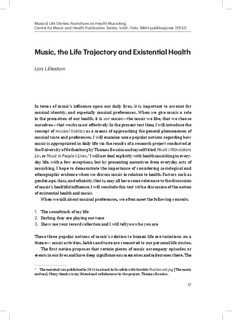| dc.contributor.author | Lilliestam, Lars | |
| dc.date.accessioned | 2014-06-12T13:37:19Z | |
| dc.date.available | 2014-06-12T13:37:19Z | |
| dc.date.issued | 2013 | |
| dc.identifier.citation | I: Musical life stories : narratives on health musicking, s. 17-38 | nb_NO |
| dc.identifier.isbn | 978-82-7853-081-8 | |
| dc.identifier.issn | 1893-3580 | |
| dc.identifier.uri | http://hdl.handle.net/11250/196378 | |
| dc.description.abstract | In terms of music’s influence upon our daily lives, it is important to account for musical identity, and especially musical preferences. When we give music a role in the promotion of our health, it is our music—the music we like, that we choose ourselves—that works most effectively. In the present text then, I will introduce the concept of musical habitus as a means of approaching the general phenomenon of musical taste and preferences. I will examine some popular notions regarding how music is appropriated in daily life via the results of a research project conducted at the University of Gothenburg by Thomas Bossius and myself titled Musik i Människors Liv, or Music in People’s Lives.1 I will not deal explicitly with health musicking in everyday life, with a few exceptions, but by presenting narratives from everyday acts of musicking, I hope to demonstrate the importance of considering sociological and ethnographic evidence when we discuss music in relation to health. Factors such as gender, age, class, and ethnicity, that is, may all have some relevance to the discussion of music’s healthful influence. I will conclude this text with a discussion of the notion of existential health and music. | nb_NO |
| dc.language.iso | eng | nb_NO |
| dc.publisher | Norges musikkhøgskole | nb_NO |
| dc.relation.ispartofseries | Centre for Music and Health Publication Series;Vol:6 | |
| dc.relation.ispartofseries | NMH-publikasjoner;2013:5 | |
| dc.subject | VDP::Humaniora: 000::Musikkvitenskap: 110::Musikkterapi: 113 | nb_NO |
| dc.title | Music, the life trajectory and existential health | nb_NO |
| dc.type | Chapter | nb_NO |
| dc.type | Peer reviewed | nb_NO |
| dc.source.pagenumber | S. 17-38 | nb_NO |
